Road & Track Performance Car of the Year 2021
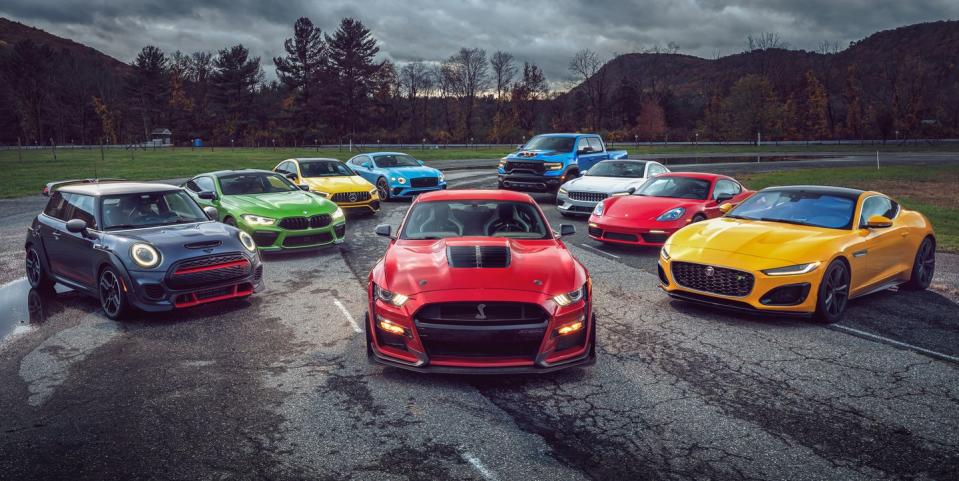
Performance Car of the Year is an event we spend months planning. We carefully select and map out the best roads; we secure a challenging race track to evaluate the cars at speed. Manufacturers send their best, most amazing new metal to compete for the crown.
This year, for our eighth running of PCOTY, we planned to go to the southeast. A fantastic road trip through the Great Smoky Mountains, topped off with track time at the fast, intricate Atlanta Motorsports Park in Dawsonville, Georgia, the home of NASCAR champs Bill and Chase Elliott. The field of cars we invited was as diverse as it was exciting. The makings of an epic week.
Like a lot of things in 2020, it wasn’t meant to be. One week before our planned departure, an email advised all staffers at our parent company to avoid interstate travel due to increasing COVID-19 risk. A multi-day road trip through states with rising positivity rates was suddenly off the table. And so, we thought, was PCOTY.
But Road & Track is nothing if not plucky. Our annual performance-car super test needed to go on. The folks at Lime Rock Park, our favorite bullring in the Northeast, quickly stepped in with two days of track time. Manufacturers rerouted cars. Our multi-day road drive through Appalachia became a day of local loops in upstate New York. Our entire staff got COVID tests; masks were mandatory.

It was a different sort of PCOTY. Where we used to spend hours whittling down each car’s lap time, now we spent just a few laps with each car to get its measure. Days of meditating over each car’s merits in every environment became urgent, empassioned discussions that needed immediate resolution. At previous PCOTY tests, we worried about oppressive heat and humidity; this year, our meteorological concern was over cold, rain, and worryingly, even snow.
Certain invitees dropped out. The McLaren 765LT, Ferrari F8 Tributo, and Porsche 718 Cayman GT4 were no longer able to participate, victims of shipping delays or quarantine rules that prevented their arrival. Replacements, like the Porsche Cayman T and—wait for it—the Hellcat-powered Ram 1500 TRX, added diversity to the field, and spurred interesting conversation.
This is a different sort of PCOTY, but the conclusion shouldn’t be a surprise.

The Contenders
Each year, we invite the most significant performance cars that have debuted in the past 12 months to participate in this group test. That means everything from high-horsepower pony cars like the 760-hp Ford Shelby Mustang GT500 to lithe sport sedans like the Mercedes-AMG CLA45. This year also included some significant cars that weren’t able to make it to last year’s test, like the Bentley Continental GT, Polestar 1, and BMW M8.
This year, we gathered up nine cars for testing at Lime Rock Park followed by a day on the surrounding country roads. Here, in ascending order of horsepower, are the competitors:

The Track
Late October in New England is a fool’s gambit. On its best days, bright sunshine pairs with glorious foliage, leaves kicking up in your wake as light peers through newly barren limbs and comfortably crisp air wafts through open windows. A film scene brought to life.
Then there’s the other side. A sky that stays the same shade of grey from sunup to sundown. A constant breeze that’s just strong enough to turn crisp air frigid. Rain that feels like liquid ice, the kind that kills plants instead of rejuvenating them. That’s the kind of weather that welcomed us to Lime Rock Park. Thankfully, the track dried before our lapping sessions, but the skies were grey and the temperature was cold the entire time.
While Lime Rock isn’t a long track, it is likely the most challenging 1.5-mile circuit in the country. One lap gives you a full understanding of a car’s dynamic abilities. And while we ran timed laps in each car, we weren’t chasing records. Each contender was allotted a couple warm-up laps, then three to four laps at speed—enough to collect a representative lap time, but not an obsessive all-day hunt to find the absolute limit in each corner.
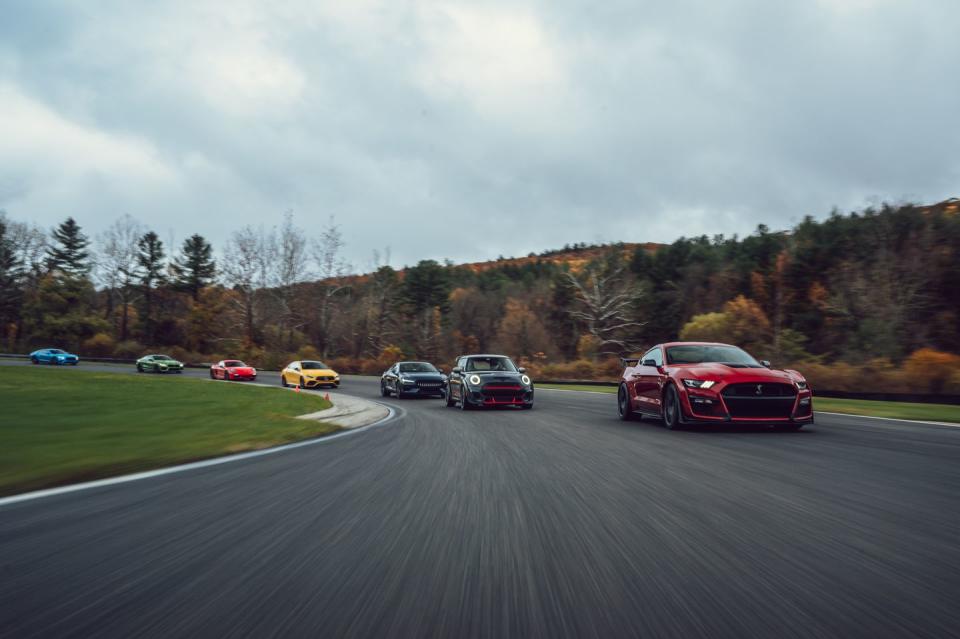
And in order to add in a little extra spice, we ran Lime Rock’s optional chicane in lieu of the fast uphill. This was partly for safety, as some of these cars would hit the uphill going fast enough to catch air. Cool to see, terrifying to experience, and a potential disaster in the waiting. We estimate this layout adds about two to three seconds to a lap time that runs the classic configuration.

The chicane added a new braking zone and a truly sharp corner to the track. The Porsche 718 Cayman T ate them up. The first car on track, it ran a 1:04.52 on its fastest timed lap. Quick, but that doesn’t tell the full story. The Porsche made lapping easy, plug and play. The overall impression was balance. Nothing felt overpowering here—even running a fast time in the car was zen-like. This was also the only car that brought three pedals to this year’s test, and thankfully, the Porsche’s shifter is exceptional, one of the finest out there. The lone complaint? The gearing is far too tall. Shorter gears would mean you shift more—the action is so satisfying, you want to be interacting with it as much as you can. The steering is also beautifully judged, wonderfully direct and accurate. Staffers agreed.

“Gorgeous balance, near perfect steering,” beamed senior reporter Chris Perkins. His notes summed up everyone’s praise, but there was one part of the car that came in for criticism: the engine.
The T has the 2.0-liter turbocharged flat-four from the base Boxster. While the numbers are great—300 hp and 280 lb-ft of torque—this isn't the flat-six calling card we’ve all come to expect, the one Porsche offers in the Cayman GTS 4.0 and GT4. While editorial director Joe Brown “wanted a little more power,” staff writer Brian Silvestro had a more scathing take, calling the engine “anemic” with “an unexciting, flat torque curve.” A common refrain with so many turbocharged cars these days.
A similar complaint was heard about the Mini Cooper John Cooper Work GP, a stripped-out version of the lovable Mini with ridiculous aero touches, no back seats, and 302 horsepower going straight to the front wheels, torque steer be damned. The Mini ran a 1:06.3 on track, about three seconds behind the lap time we clocked on the traditional track layout in warmer conditions earlier this year.
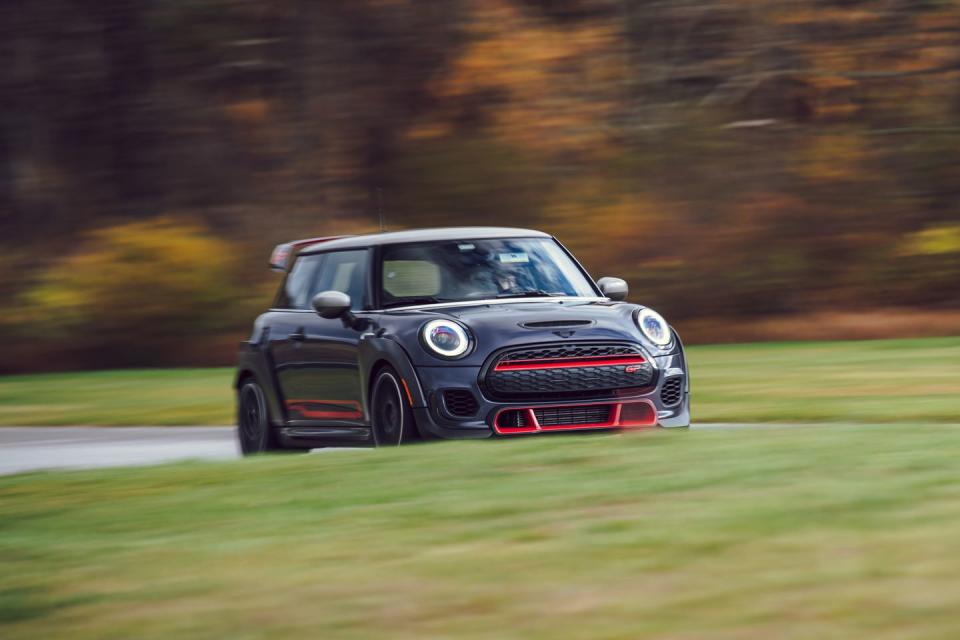
It’s still an animal, a rowdy bulldog that needs you to take charge and actually control the torque steer. It’s refreshing fun, and it shows: Drivers lined up for a chance in the Mini, their notebooks full of praise. Associate editor Mack Hogan said it “feels like the simple flickable hatch you want” while Silvestro called it “fun to muscle around.”
[Note: Due to an equipment malfunction, we were not able to record video of the Mini's lap.]
But there are issues. The engine, a 2.0-liter turbo four sourced from BMW, is characterless, the power dropping off about 1000 rpm before redline. And when left to its own devices, the gearbox, as contributor Dave Burnett put it, is “as dumb as a bag of hair.” But leave it in manual and short-shift it on acceleration, and there’s plenty of thrust.

It was a similar procedure with the Mercedes-AMG CLA45, the brand’s smallest sedan paired with the world’s most powerful production four-cylinder. With 382 hp and 354 lb-ft, we expected the little Merc to be quick. And this one had extra-sticky rubber, Pirelli Trofeo Rs, a $2900 option we expected would make it quick on track. It was. The 1:04.55 it turned was right on par with the Cayman. But those special tires aren’t what you’d want for road use. They need aggressive swings of the wheel to come up to temp before they’ll make any grip.
The engine is a little firecracker, loud and brash, a hornet's nest waiting to be deployed. But it’s so buzzy, it can echo in your head. At times, the racket was so indiscernible, I wouldn’t notice that the car had denied me a downshift, which it will do in braking zones if you grab the paddle too early for the car’s liking. Still, the little Merc came in for its fair share of acclaim, Hogan saying that it “feels eager and incredibly sharp on turn in” and web editor Aaron Brown saying that “this where I feel most at home.” You can see why. It’s the right size. It feels refined yet brazen. It’s fast in a straight line and adjustable in a corner, with a playful tail, and has an interior that seems to be taken directly from a mid-priced European hotel. The Mercedes-AMG Ibis.
If you want to upgrade to the Ritz, though, you’ll need the Continental GT V-8. This is not a track car. Not even close. If the gorgeous leather-and-wood interior—which Silvestro said “smelled amazing”—wasn’t a hint, then the 5000-lb curb weight body-slams the point home.

Like most cars from the VW Group, the Bentley shares underpinnings with oodles of other models. This British brute is most closely related to the Porsche Panamera, right down to the 4.0-liter twin-turbo V-8 (here making 542 hp and 568 lb-ft) and the eight-speed dual clutch gearbox.
You’re prepared for it to be a wonderful long-distance cruiser. What you’re not prepared for is how much actual fun it provides on track. It runs a 1:04.92, comparable to both the Porsche and the Mercedes, but it’s more hilarious getting there. You throw it up on curbs to get it turned and just trust that the massive brakes will slow it down repeatedly every lap. The steering is numb—you rely on your other senses, not your fingertips, to tell you what the front end is doing—but the chassis is well damped and controlled, becoming more and more fun as you push it.
Perhaps the joy is in the unexpected nature of it all. While other automakers worry about stripping out weight, you’re in your living room, getting a back massage, while cutting sub-1:05 lap times. “I didn’t expect to like this car as much as I do,” noted deputy editor Bob Sorokanich. He speaks for all of us.
That sort of kindness didn’t extend to the Jaguar F-Type R, now with a new nose and 575 hp on tap. Jag has adjusted the damping and calmed the whole package down, toning down the boisterous exhaust that popped and banged and occasionally sounded broken in favor of a more subdued note. It all should add up to a fantastic package on the street.
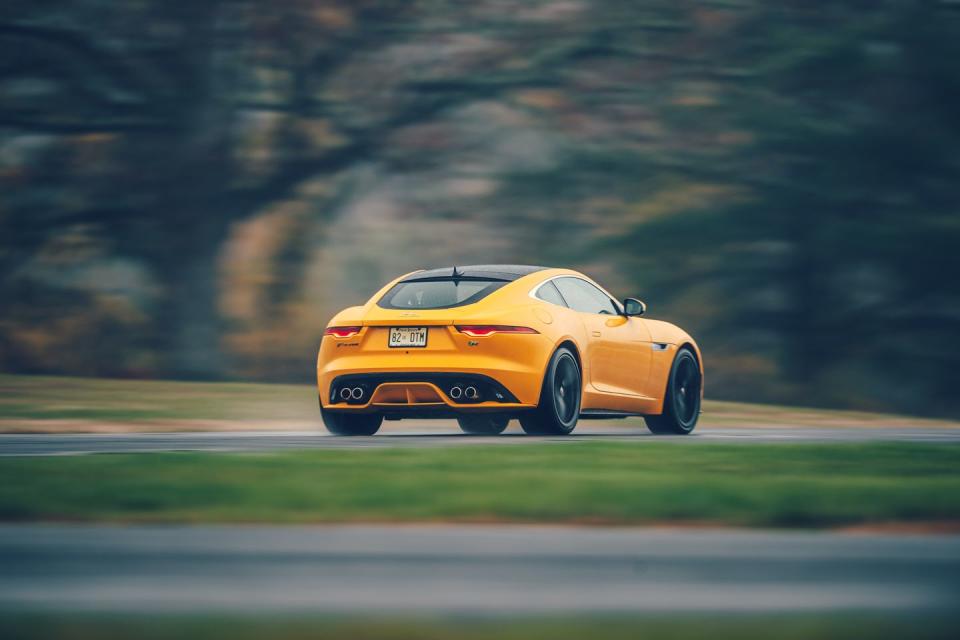
But PCOTY is predominantly a track test. While the Jag ran a 1:03.59 and was touching 140 mph on the front straight, it was easily the scariest to drive in this group. In fast right-hand corners—i.e., most of Lime Rock—the weight transfer would lift the back end and create an unstable mess, where you’re cranking the wheel to the left to keep the rear in check. As editor-in-chief Mike Guy said, “the rear end gets real light real quick. It’s fast in a straight line but nerve wracking at the limit.”
A shared sentiment, and especially disappointing because the F-Type used to be lairy on command, tossing in oversteer with a stab of the throttle—not on corner entry where you need to trust it not to bite you. That said, the engine is still a monster, as Silvestro noted, with “a fat powerband.” That supercharged 5.0-liter V-8 is matched to a gearbox that’s good and bad. The good: it’s quick and listens to your commands. The bad? The shifts are abrupt and rough, unsettling the car’s already precarious balance mid-corner. A track car this is not. Perkins summed it up with one word: “Terrifying.”
Our first plug-in hybrid PCOTY contender also isn’t meant as a track car, but it is an intriguing new take on performance. The Polestar 1 uses a turbo-and-supercharged 2.0 liter four-cylinder and an integrated electric motor to drive the front wheels plus twin electric motors on the rear axle to bring output to a wonderful 610 hp. It’s gorgeous, pure Swedish concept fantasy brought to life with huge 22-inch wheels, fat arches, and a delightful window in the trunk bulkhead that lets you look at the electric drivetrain circuitry. There’s also plenty of sporting hardware, with adjustable Ohlins shocks and Akebono brakes big enough to serve Thanksgiving dinner off of.
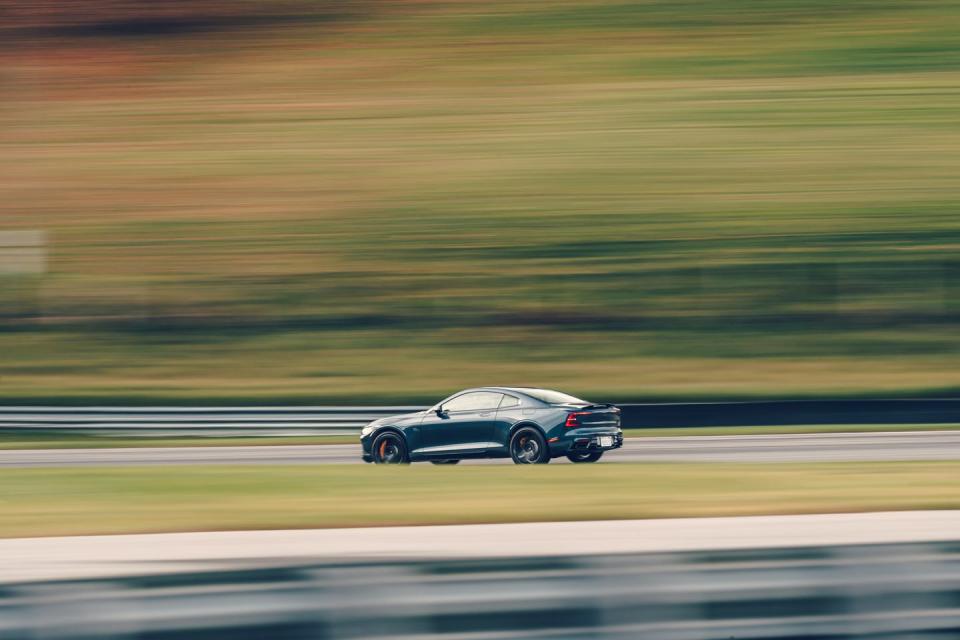
Those brakes might be the most impressive part of the car. The Polestar is heavy—nearly 5200 lbs—but its brakes feel like they could stop a semi in record time. The pedal response is sharp and immediate, and the 1 sheds speed unlike any other car here. Truly a joy. But the drivetrain calibration lets the 1 down. The Polestar’s 1:07.36 lap time is a reflection of the hybrid drive system seemingly getting confused at certain parts of the track, hesitating to put the power down or taking a second to react to throttle inputs.
The lap time doesn’t tell the full story, though, since there’s a lot of complex and interesting stuff happening here. The torque-vectoring rear axle helps the rear end rotate, and the suspension is high-end stuff that’s extremely talkative. Like the Continental GT, this is not a track car, so the steering is numb, and the whole package is clearly not tuned for lapping. It’s divisive, with some on staff calling it “interesting” and “brutally fast” and others calling it “boring” and “distant.” But a great GT car isn’t meant for everyone. It needs to appeal to a niche and go all-in. The Polestar is aimed at a certain type of buyer, one who probably won’t be chasing lap times.
Time for the M8 Competition. BMW’s flagship coupe might bring back a classic model line, but in reality, like the M6 before it, this M8 is basically an M5 with a different body. It does have all the tech, with an eight-speed automatic and more modes and settings for everything than you could possibly need. You can even disconnect the front axle to make it rear-wheel drive.

One thing is for sure: It’s bananas quick, putting down a 1:02.06 in just three hot laps, with room to go even quicker. One thing it could have used to put down speed more easily: grippier tires. The P Zeroes on here just didn’t cut it—they lost gobs of time mid-corner when g-loads got higher, and they got greasy as temps increased. But a stickier tire would sacrifice the car’s well-roundedness on the road.
The engine is a star. The M8’s 4.4 liter V-8 has 617 hp, 553 lb-ft of torque, and feels like it’s always in the power band. For an engine architecture that’s shared across so many models, it feels far more exotic than it is, a testament to the engineers in Munich. It’s paired with ZF’s 8HP automatic, a gearbox that’s nearly ubiquitous in performance cars now. BMW’s tuning of the box is outrageously good. It feels more like a dual-clutch than a conventional torque-converter transmission, with quick, smooth shifts and no lag between gears.
But while the BMW does everything objectively well on track, there’s something missing. It’s a tired refrain with modern BMWs, that they’re not what they used to be, but it still rings true. The M8 is fast, with outstanding brakes, and it can obviously obliterate a track, but it does it in a way that feels clinical. It’s without joy, like it wants to please a stopwatch more than a human. Hogan put it best: “Technically good, you just won’t be having any fun. How does this BMW make light oversteer in a 600-hp monster feel so boring?”

 Yahoo Autos
Yahoo Autos 